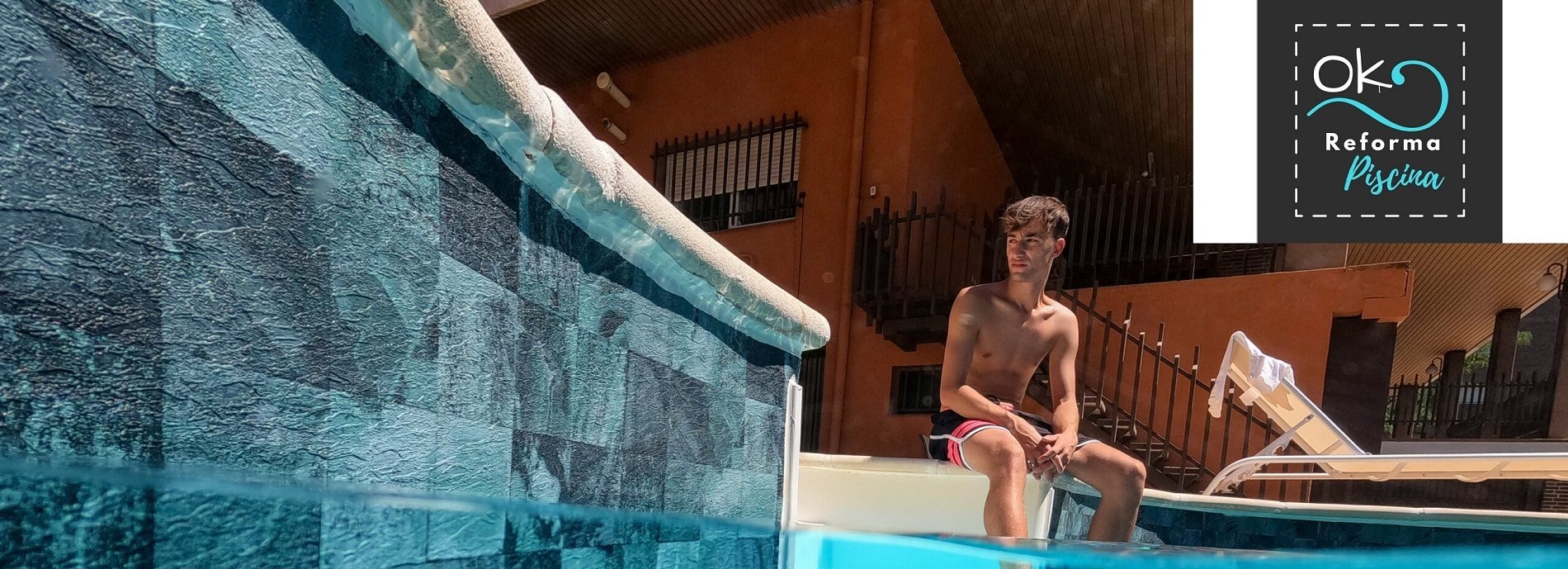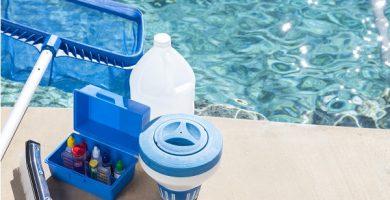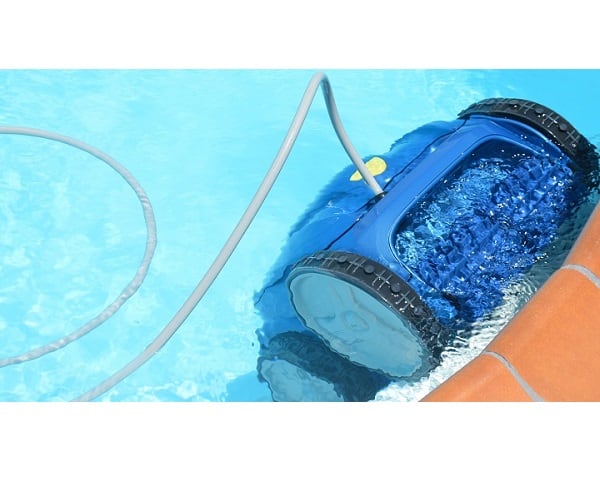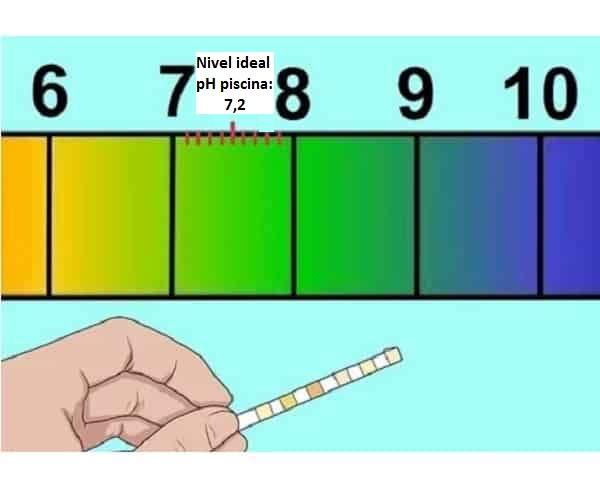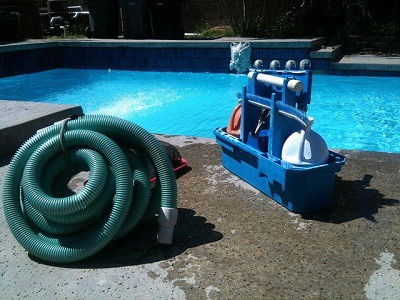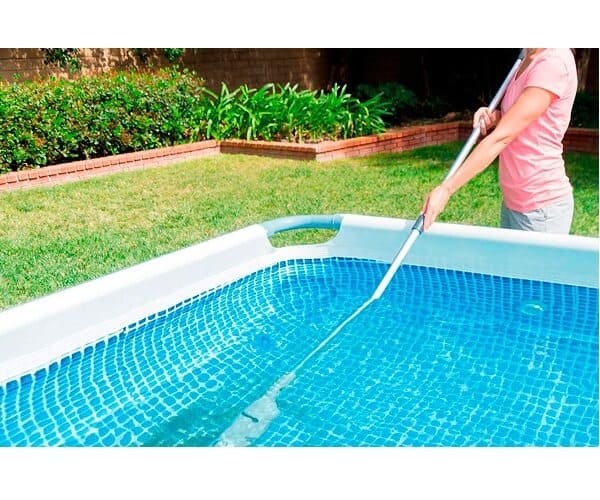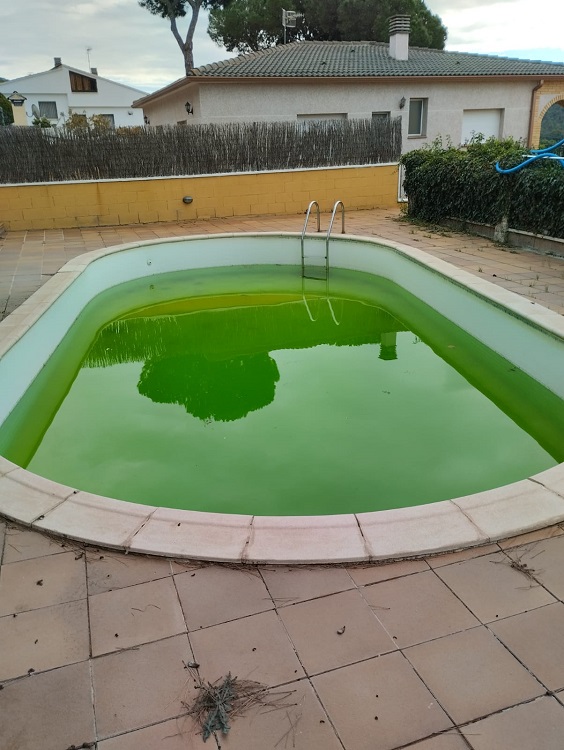
On this page of Ok Pool Reform within Pool filtration and in the section Pool purifier We present all the details of Tips to effectively clean a green pool: what you should know
Table of contents of the page
How can I clean a green pool?
If you have a green pool, it is important to clean it as soon as possible. You can do this in several ways, but the most important thing is to be thorough.
One way to clean a green pool is to use a pool vacuum cleaner. This will help remove any debris floating on the surface of the water. You'll also want to be sure to vacuum the walls and floor of the pool to remove any algae or other growth.
Another way to clean a green pool is to use chlorine tablets. These can be placed in the skimmer basket or in a floating dispenser. The chlorine will help kill any algae or bacteria that are growing in the pool.
You may also consider using a pool shock. This is a chemical substance that is added to water and helps break down any organic matter present. This can be an effective way to clean a green pool, but you'll want to make sure you follow the instructions carefully.
Lastly, be sure to brush the sides and bottom of the pool. This will help remove any dirt or residue that has built up over time. If you have an above ground pool, you may also consider power washing the sides of the pool.
By following these tips, you should be able to effectively clean a green pool. Remember, it's important to be thorough when cleaning your pool so you can enjoy it for years to come!
How can I restore the shine to my pool?

There are many ways to restore the shine to your pool. Some people prefer to use chemical cleaners, while others opt for natural methods. Regardless of which path you choose, there are a few things you can do to ensure your pool shines like new.
One of the easiest ways to restore the shine to your pool is to use a commercial pool cleaner. These products are designed to clean the walls and bottom of your pool, as well as remove any dirt, debris or stains that may be present. Be sure to follow the pool cleaner's instructions carefully, as using too much or too little of the product can damage your pool.
In addition to using a commercial cleaner, you can also restore the shine to your pool by giving it a shock. This process involves adding a large amount of chlorine or another disinfectant to the water to kill any bacteria that may be present. Shocking your pool regularly is a great way to keep it looking its best.
If you prefer not to use chemicals, there are several natural methods you can use to restore the shine to your pool. A popular method is to add white vinegar to the water. Vinegar is a natural disinfectant and will help remove any buildup that may have occurred on the sides or bottom of your pool. Another option is to use lemon juice or baking soda. These natural substances will also help break down any dirt or debris that has accumulated in your pool.
Finally, remember that proper maintenance is key to keeping your pool sparkling like new. Be sure to brush and vacuum your pool regularly, and make sure the water's pH levels are balanced. By following these simple tips, you'll be able to enjoy a sparkling clean pool all summer long!
What are the best ways to clean a green pool?
The best ways to clean a green pool are to use chlorine, give the pool a shake, and brush the walls and floor. Chlorine is the most effective way to eliminate bacteria and algae. Shock the pool by adding a large amount of chlorine at once. This will kill any algae that is present. Brush the walls and floor to remove any dirt or debris that may be present.
1st way How can I clean a green pool?
How to clean the green pool and recover the water without emptying it

What is green pool water? Or the same: green algae in the pool

How to identify and eliminate pool algae according to its type?

How to recover green pool water: Goodbye to the green pool, complete rescue guide

Is the salt pool exempt from having green water?
Cleaning a green pool: What you should know
Looking for ways to clean a green pool? Having a green pool is a common problem many pool owners face. It is important to take the necessary steps to properly clean your pool to avoid having to replace it. In this article, you will discover what you need to know to clean your green pool and return it to its original state. From gathering the right products and tools to the steps you should take to reduce green algae, you will be able to clean your pool successfully.
Gather the necessary products and tools
When it comes to pool care, one of the most important steps is gathering the items and materials needed to get the job done. This includes a brush, skimmers, vacuum cleaner, chemical balance kit, unstabilized chlorine, pH modifiers, and protective gloves.
Having the right supplies is key to effective treatment. A chemical balance kit is especially useful for managing the amount of chlorine needed to disinfect the pool. Unstabilized chlorine is good for eliminating algae, while pH modifiers can be used to control the acidity of the water and keep it within an acceptable range. Additionally, you should always wear gloves to avoid any skin irritation caused by harsh chemicals.
Chlorine shock treatment

Green water pool shock treatment Eliminate green water from your pool in just a few steps

Shock treatment for swimming pools with saline chlorinator: The efficient solution for crystal clear water»

How to use shock chlorine

What is pool shock treatment?
When it comes to disinfecting a pool, shock with chlorine is essential. To ensure the elimination of unwanted organisms such as bacteria and algae, a large dose of chlorine is added to the water. It is important to ensure that the area is well ventilated before beginning the process, as chlorine can be dangerous. Once the shock treatment is complete, it is essential to check the chlorine levels in the pool to ensure that the desired effect has been achieved. If levels are too low, a second shock treatment may be necessary. Additionally, the water may become cloudy, but this should disappear once the filter is in operation.
In summary, chlorine shock treatment is an effective and safe way to eradicate any unwanted organisms from a pool. It is important to take the necessary precautions and then monitor chlorine levels to ensure satisfactory results.
Use a brush to clean the pool
Treating a cloudy pool can be a difficult task, but with the right materials and knowledge, it can be accomplished successfully. An essential piece of equipment for treating a cloudy pool is a brush, which can be used to remove algae, dirt, and other particles from the walls and bottom of the pool. To ensure that the pool is completely clean, it is important to use a brush made specifically for cleaning pools.
When using a brush to clean a cloudy pool, it is important that you start at the top and work your way down. This will help ensure that all algae and dirt are removed and the pool is completely clean. It is important to use a circular motion when scrubbing the walls and bottom of the pool as this will help release and remove any lingering particles.
Once the pool is completely cleaned with the brush, it is important to vacuum the bottom and walls. This will help remove any debris that the brush may have missed. Vacuuming can also help reduce the amount of algae and dirt in the pool, which will help keep the water looking clean and clear.
Steps to clean green water
It may seem intimidating to deal with a cloudy pool, but with the right steps, you can easily get your pool looking beautiful. Start by gathering the necessary supplies and equipment, such as a brush, sweepers, vacuum cleaner, pH measurement kit, unstabilized chlorine, pH reducers or increases, and gloves.
Once you're ready to get started, it's time to take action. Start by disinfecting the pool with a chlorine shock treatment to eliminate algae. If there is a large amount of algae, you may have to repeat the process. Next, use a brush to scrub the walls and bottom of the pool, and vacuum up any dead algae. To get rid of hard-to-grab particles, add a flocculant.
Now is the time to start cleaning the water. Use a robot vacuum cleaner to remove impurities from the bottom. Increase the pH of the water to between 7,2 and 7,6 to make it less conducive to algae. To sanitize the water, add chlorine and quickly dissolving salt, about 4 kilos of salt per cubic meter. Lastly, use a skimmer to lift floating debris from the water and scrub the bottom of the pool.
Clean with Robot Vacuum Cleaner
Ensuring a clean and healthy pool is essential for safety and enjoyment. One of the best ways to do this is by using a robot vacuum cleaner. This device is designed to effectively remove impurities and sediment from the bottom of the pool.
The process of using a robot vacuum cleaner is relatively simple. All you have to do is place it in the pool, plug it in and let it do its job. As the robot moves along the bottom of the pool, it picks up dirt and debris that would otherwise remain in the water. It is important to note that this step must be done before using any other cleaning method.
Once the robot has finished its work, it is necessary to carefully inspect the pool to ensure that all impurities have been removed. If any remains, it may be necessary to vacuum more with the robot. Additionally, it is a good idea to check the robot's filter from time to time, as it may need to be cleaned or replaced depending on the amount of debris that has been collected.
Robot vacuum cleaners are an effective way to keep a pool clean and safe. This method is an integral part of the process and should be done before taking any other measures to ensure the pool is as sanitary as possible. With the help of a robot vacuum cleaner, a pool can be cleaned quickly and satisfactorily.
Increase the pH of the water
Maintaining a healthy swimming environment is essential, and the key to this is ensuring that the pH levels of your pool water are within the proper range. The optimal level for this is 7,2 to 7,6, and this can be achieved using a combination of baking soda and citric acid. This mixture must be added in the correct proportions to achieve the desired result.
Alternatively, a pH increaser can be used to raise pH levels over time without the need for manual measurements. However, it is important to note that these chemicals must be monitored and maintained to ensure that pH levels remain in the optimal range and are not too high, which can damage the pool.
In case the pH levels are too high, a pH reducer can be added to the pool water to bring the levels back into the optimal range. This chemical lowers pH levels over time and, again, must be monitored and maintained regularly.
In summary, it is of utmost importance to keep pool water pH levels within the optimal range to maintain a healthy swimming environment. This can be done by adding a mixture of baking soda and citric acid, or by using pH increasers and reducers. Whichever method is chosen, it is essential to regularly monitor and maintain pH levels, as too high or too low can cause costly damage.
Use salt as a homemade product
For those looking for a natural and effective solution to pool discoloration, salt could be the answer. Adding quick-dissolving chlorine and about 4 kilos of salt per cubic meter will help eliminate impurities, disinfect the water and restore its clear appearance.
Salt helps create a less hospitable environment for algae, while softening the water and making it more comfortable for bathing. It is important to note that salt can corrode pool equipment such as the filter, pump and heater, so it is recommended to consult the manufacturer's instructions for the recommended salt concentration.
This homemade solution is a great alternative to traditional cleaning treatments and products. It is an effective way to keep algae away, while disinfecting the water and restoring its clarity.
Salt is an excellent, natural remedy for pool discoloration. To get the most out of this homemade solution, it is important to be aware that it can cause corrosion to pool equipment and follow the manufacturer's guidelines for the ideal salt concentration.
Cleaning the bottom and walls of the pool
To keep your pool in perfect condition, it is essential that you maintain it regularly by brushing and sweeping any dirt or debris. Start by scrubbing the bottom and walls, focusing on the areas most laden with algae. This will help break up the algae and make it easier to remove. Then use sweepers to remove algae and any other unwanted material. Make sure you cover the entire pool, not just the affected areas.
Once you're done brushing and sweeping, use a vacuum cleaner to remove any remaining particles. Be sure to vacuum the entire area, including the bottom and walls, to keep the water free of stubborn algae. This is an essential step in maintaining a spotless pool, as it will keep out any harmful materials and ensure the water remains clean.
Remove dirt floating in the water
Having a sparkling pool can be a great way to relax and enjoy the summer months. However, it is important to keep your pool in good condition to ensure safe swimming and a healthy environment. One way to do this is to regularly clean the pool of dirt, debris, and algae.
Pool cleaners are an effective tool to carry out this task. To use one, you first have to remove the filter basket and discard the collected debris. Next, lower the skimmer into the pool and tilt it so that it is just below the surface of the water. Finally, sweep the device from one side to the other to collect all floating materials. Emptying the skimmer regularly will prevent the filter from becoming clogged and ensure that the pool remains clean.
It is also important to ensure that the skimmer is clean of any dirt or debris. This will help maintain water clarity and prevent pool discoloration. By following these simple steps, you will ensure that your pool looks its best.
Conclusion
Maintaining a green pool can be a daunting task, but with the right products and tools, it can be done. Cleaning, disinfecting and checking the pH of the water regularly are essential steps to keep your pool clean and healthy. With proper maintenance and care, you can ensure that your pool is always a safe and enjoyable place to swim and relax.
2nd way How can I clean a green pool?
What happens if the pool water remains green?
Pool shock treatment
3rd way How can I clean a green pool?
What happens if the water turns green again?
Flocculate pool

Remove pool algae: eliminate them in a long and effective way

Cartridge flocculant for pools with saline chlorinator: remove turbidity in pool water
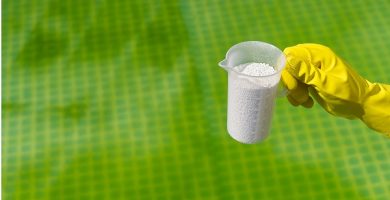
What is flocculant, when to use it and how to flocculate a pool
Tips to prevent a green pool in the future
A green pool is the bane of every swimmer's existence. No one wants to jump into a pool of cloudy water, and no one wants to watch their once-clear pool turn a shade of green. But it can happen, even if you take all necessary precautions.
So what causes a green pool and how can you avoid it in the future?
How to prevent water from turning green
There are a few things that can cause a green pool. One of the most common is simply algae. Algae love warm, sunny environments, making swimming pools the perfect breeding ground for them. Algae can also get into your pool if you swim in a lake or river that has it; It is enough for one person to drag them.
Another common cause of green pools is poor filtration. If your filter is not working properly, it will not be able to remove all contaminants from the water, including algae. This means that algae will continue to grow and your pool will turn green.
There are a few things you can do to avoid a green pool in the future. First, make sure you have a good filtration system. This will ensure that any algae or other contaminants are removed from the water before they have a chance to take hold. Second, regularly check your pool for any signs of algae growth, and treat it immediately if you notice any. Finally, don't let anyone swim in your pool if they've been swimming in a lake or river - this is how algae often gets into pools in the first place.
A green pool can be due to several causes, but the most common is algae. Algae can enter your pool in several ways, such as wind, rain, and even through bathers who have been in another body of contaminated water. Although algae are not harmful to humans, they can give your pool an unattractive appearance and make the filter work harder than it should.
There are a few ways to clean a green pool, but the most effective is to use a pool shock product. Pool shock is a chlorine-based product that kills algae and other bacteria in your pool. You can also use algaecide, which is a chemical that prevents algae from growing in your pool.
To prevent your pool from turning green in the future, there are a few things you can do. First, make sure you are regularly checking and adjusting your pool's pH levels. You should also ensure that you are using a quality pool filter and that you are regularly cleaning your pool cover and surrounding area. Lastly, don't forget to brush the walls and floor of your pool at least once a week!
